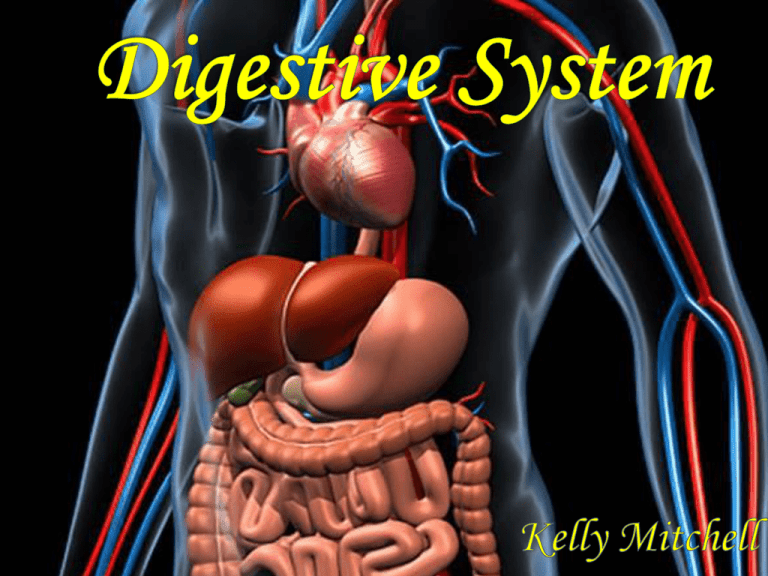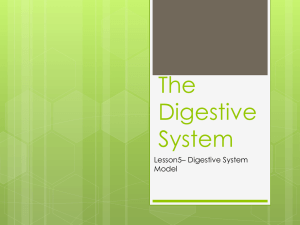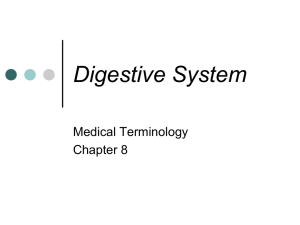
This system is uniquely constructed to perform its
specialized function by turning food into the energy
we need to survive and prepares the residue for
waste disposal.
The roles of the Digestive System are to:
› take in food
› break food down into nutrient
› molecules
› absorb molecules into the
› bloodstream
› rid the body of indigestible remains
The process of the Digestive System: (food becomes less
complex at each process)
› ingestion (taking in of food)
› Propulsion (movement of food through the GI tract)
› mechanical digestion (food is prepared for chemical )
› chemical digestion (complex food molecules are broken
down into chemical building blocks)
› Absorption (digested end products, vitamins, minerals and
water are passed)
› Defecation (indigestible substances are eliminated through
the anus)
The organs of this system can be separated into two
main groups: those forming the alimentary canal, and
those forming the accessory digestive organs
The alimentary canal digests food, breaks it down
into smaller fragments, and absorbs the digested
fragments through its lining in the blood.
The accessory organs includes: the teeth, tongue, gall
bladder, and digestive glands such as: the pancreas,
liver, and salivary glands.
This is also called the gastrointestinal or the GI tract which
is a continuous, coiled hollow muscular tube that winds
through the ventral body cavity and has openings at both
ends.
Its organs include: the mouth, pharynx, esophagus,
stomach, small intestine, large intestine, and anus.
The essential activities of the GI tract are:
› Ingestion
› Propulsion
› Food breakdown or mechanical digestion
› Absorption
› Defecation
The digestive tract consists of:
Mouth
Esophagus
Stomach
Small intestine
Large intestine (includes the colon and rectum)
Anus
Organs that Help with digestion:
Tongue
Pancreas
Liver
Gallbladder
The mouth begins the digestive tract.
By chewing the food, this allows the body to be
more easily digested.
The saliva in the mouth mixes with the food in your
mouth and begins to break it down so your body can
absorb the food.
The frenulum which is a fold of mucus membrane,
secures the tongue to the floor of the mouth and
limits its posterior movements.
The mouth in located in the center of the face
Food enters the digestive tract through the
mouth, or oral cavity which is a mucous
membrane lined cavity.
The lips protect its anterior opening, the cheeks
form its lateral walls, the hard palate forms its
anterior roof, and the uvula is a fleshy fingerlike
projection of the soft palate, which extends
downward from its posterior edge.
The area contained by the teeth is called the oral
cavity proper.
Saliva is secreted by glands.
They are located in and outside the oral cavity.
The functions of the glands are:
› cleanse the mouth
› dissolve chemical food so it can be tasted
› moisten food & compact it into a bolus
› contain enzymes which begins the chemical digestion
of starchy foods
This is located in your throat near your Trachea or
windpipe.
Food travels to the Esophagus when it leaves your
mouth.
This organ transfers food to your stomach by
peristalsis or muscular contractions.
The stomach is a hollow “container” which holds
food while it is mixed with enzymes.
The enzymes continue to break down food into a
form the body can use.
The cells in the lining of the stomach give out a
strong acid and powerful enzymes. These aid in the
breakdown process.
When the food in the stomach is completely
processed, they are released into the small intestine.
The activities of the stomach are food breakdown
and food propulsion.
The stomach is a sac-like organ which has strong
muscular walls.
The stomach is located in the lower abdominal cavity
of the torso.
The small intestine is made up of three parts: the
duodenum, jejunum, and ileum.
This is a 22 foot long tube that uses enzymes to
break down food.
The enzymes are released by the pancreas and bile
from the liver.
Peristalsis or involuntary contractions move food
and cause it to mix with digestive secretions from the
liver and pancreas.
The duodenum, the first part of the small intestine,
is mostly responsible for the breaking-down process,
and the jejunum and ileum are mainly responsible for
nutrient absorption into the bloodstream.
The small intestine’s contents start out semi-solid,
and end up as a liquid form after going through the
small intestine.
The change in consistency is caused by: water, bile,
enzymes, and mucous.
Once the nutrients are absorbed and the leftover food
liquid residue has passed through the small intestine,
it then moves on to the colon or large intestine.
Activities of the small intestine are food breakdown
and absorption and food propulsion.
The Large Intestine is a 6-foot long muscular tube
that connects the small intestine to the rectum.
This organ is made up of the cecum, the ascending
(right) colon, the transverse (across) colon, the
descending (left) colon, and the sigmoid colon,
which also leads to the anus or terminal opening.
The appendix is a small tube which is attached to
the cecum.
This organ is a highly specialized which is
responsible for processing waste so emptying the
bowels is convenient and easy.
Waste left over from the digestive process is
passed through the large intestine by peristalsis,
first in a liquid state and ends up in a solid form.
As waste passes through the colon, water is
removed.
Waste is stored in the sigmoid or the S-shaped
colon until a mass movement empties it into the
rectum once or twice a day.
This process normally takes about 36 hours for
waste to get through the colon.
The waste is made up of mostly food debris and
bacteria.
These bacteria perform several useful functions such
as: producing various vitamins, processing waste
products, processing food particles, and protecting
against harmful bacteria.
When the descending colon becomes full of waste it
empties its contents into the rectum which begins the
process of elimination.
Activities of the large intestine are food breakdown
and absorption and propulsion of the residue and
defecation or discharge from the anus.
The teeth breaks down food in order to allow for easier digestion.
The Dental pulp’s function are:
› connective tissue, blood vessels & nerve fibers
› fills the pulp cavity enclosed by dentin
› supplies nutrients to tooth tissues
› provides for tooth sensation
The dentin in teeth is:
› bone like material
› underlies the enamel cap
› forms the bulk of the tooth enamel
› acellular, brittle, mineralized material
› bears the force of chewing
The muscular tongue occupies the floor of the
mouth.
The tongue has several bony attachments two of
which are to the hyoid bone and the styloid bone
processes of the skull.
The pancreas secretes digestive enzymes into the
duodenum which is the first segment of the small
intestine.
The enzymes in the pancreas break down
carbohydrates, fats, and, proteins.
The pancreas makes insulin, and secretes it
directly into the bloodstream.
Insulin is the main hormone used for
metabolizing sugar.
The pancreas is located in the lower cavity or the
abdominal cavity.
The liver has many functions, but its main function
in the digestive system is processing the nutrients
absorbed in the small intestine.
Bile from the liver is secreted into the small intestine
and plays an important role in the digestion of fat.
The liver is in a sense the body’s chemical "factory."
The liver takes the raw materials absorbed by the
small intestine and makes all the chemicals the body
needs to function.
This organ also removes potentially harmful
chemicals.
It breaks down and gives off many drugs.
The liver is located in the lower cavity or the
abdominal cavity.
The gallbladder is a thin-walled, green sac.
It is also a ventral surface of liver.
The function of the gallbladder is to store bile that is
not immediately needed for digestion.
The gallbladder also concentrates the bile by
absorbing some of its water and ions.
The rectum is an 8-inch chamber that connects the
colon to the anus.
The rectum receives waste from the colon, lets the
person know that there is stool to be evacuated, and
holds the stool until evacuation happens.
When gas or waste comes into the rectum, sensors
send a message to the brain.
The brain decides if the waste contents are able to be
released or not.
If they can be released, the sphincters or muscles
relax and the rectum contracts and disposes of its
contents.
If the contents can’t be disposed, the sphincter
contracts and the rectum accommodates so that the
sensation goes away temporarily.
The anus is the last part of the digestive tract.
It is a 2-inch long canal which consists of the pelvic
floor muscles and the two anal sphincters both
internal and external.
The lining of the upper anus is designed to detect
rectal contents.
The anus lets you know whether the contents are
liquid, gas, or solid.
The anus is surrounded by sphincter muscles that are
important in allowing the control of stool.
The pelvic floor muscle creates an angle between the
rectum and the anus which prevents stool from
exiting when it is not supposed to.
The internal sphincter is always tight, except when
stool comes into the rectum.
This organ keeps us content when we are asleep so
we are unaware of the presence of stool.
When we get an urge to go to the bathroom, we rely
on our external sphincter to hold the stool until
reaching a toilet, where it then relaxes to release the
waste.
In amphioxus, which is any genus of lancelets, the
digestive tract consists of only three parts: the oral
cavity, the pharynx, and a tubular post pharyngeal,
pharynx region, gut without subdivisions. The same
condition holds in the most primitive living
vertebrates such as lampreys and hagfishes.
In higher vertebrates the post pharyngeal gut is
almost always subdivided into a series of regions that
are both anatomically, part of the body, and
functionally distinct. The most common is the
esophagus, stomach, small intestine, large intestine,
The integumentary system- provides nutrients
needed by the skin.
Skeletal system- provides calcium and other
nutrients for bone repair and growth.
Muscular system- provides glucose for muscle
activity; the liver metabolizes lactic acid following
anaerobic muscle activity.
Cardiovascular system- provides nutrients for plasma
protein formation and blood cell formation; liver
detoxifies blood, makes plasma proteins, destroys
old red blood cells.
Lymphatic system- digestive tract provides nutrients
for lmphatic organs; stomach acidity prevents
pathogen invasion of the body
Respiratory system- breathing is possible through the
mouth because the digestive and respiratory tract
share the pharynx
Urinary system- liver synthesizes urea; digestive
tract excretes bile pigments from the liver and
provides nutrients
Reproductive system- digestive tract provides
nutrients for growth and repair of organs and for
development of the fetus
Nervous system- digestive tract provides nutrients
for growth, maintenance, and repair of neurons and
neuorglia
Endocrine system- the stomach and small intestines
produce hormones
Communication to maintain homeostasis can occur through the
nervous system or through chemical stimulation. One part of the
nervous system controls the communication network that regulates
bodily functions. This part of the nervous system functions without a
person's thinking about it and without much noticeable indication that
it is working. Chemicals used to communicate are called transmitters.
Transmitters that are produced by one organ and travel to other
organs through the bloodstream are called hormones. Transmitters
that conduct messages between parts of the nervous system are called
neurotransmitters.
One of the best known transmitters is the hormone adrenaline. Within
moments, this chemical has the entire body on alert, a response
sometimes called the fight-or-flight response. The heart beats more
rapidly and powerfully, the eyes dilate to allow more light in,
breathing quickens, and the activity of the digestive system decreases
to allow more blood to go to the muscles. The effect is rapid and
intense.
Through the digestive system the body acquires the
food it needs to fuel cells. The main food source
needed are carbohydrates broken into glucose
molecules. The cell breaks the glucose into
something smaller and sends it off to the
mitochondria. There the mitochondria uses these
smaller pieces added to oxygen to make energy for
you.
The arrangement of the organs allows the food to
properly be prepared in the mouth then digested into
the stomach and eventually expelled through the
anus. The food must be broken down before it can
travel down the esophagus and be churned in the
stomach and expelled as waste through the anus.
Feedback control is a response within a system that
influences the continued activity or productivity of
that system. It is the control of a biological reaction
by the end products of that reaction. It also helps
maintain homeostasis in the human body.
Also called Heat Regulation, it is the maintenance of
an optimum temperature range by an organism.
Cold-blooded animals pick up or lose heat by way of
the environment, moving from one place to another
as necessary. Warm-blooded animals have additional
means by which they can heat and cool their bodies.
Muscular activity can be an important source of heat
in both kinds of animals. In the same way humans
must maintain how hot and cold they get and how
much water the body contains.
Marieb, Elaine N. (2000). Essentials of Human Anatomy and Physiology.
Holyoke, Massachusetts: Addison Wesley Longman, Inc.
Marshall, Karen. The Digestive System. Retrieved from
http://www.montgomerycollege.edu/~kmarshal/BI205/ppt/chapt23-4.pdf.
human digestive system. (2013). In Encyclopedia Britannica. Retrieved
from http://www.britannica.com/EBchecked/topic/1081754/humandigestive-system/45382/Evolutionary-development.
Maintenance of the Human Body: Digestive System and Nutrition.
McGraw-Hill. Retrieved from http://highered.mcgrawhill.com/sites/dl/free/0072347325/80938/mhb8ch05.pdf.
Na’auao, Ka Hana ‘Imi. (2009). Cellular Respiration. Ka Hana ‘Imi
Na’auao. Retrieved from
http://www.cds.hawaii.edu/kahana/downloads/curriculum/SectionII/Unit5/
Unit5Appendix/5.X.B.CellularRespiration.pdf.
(2009). Disease and Conditions. The Cleveland Clinic Foundation.
Retrieved from
http://my.clevelandclinic.org/anatomy/digestive_system/hic_the_structure
_and_function_of_the_digestive_system.aspx.
Beers MD, Mark H. (2006). Organ Systems. The Merck Manual Home
Health Handbook. Retrieved from
http://www.merckmanuals.com/home/fundamentals/the_human_body/org
an_systems.html.
thermoregulation. (2013). In Encyclopedia Britannica. Retrieved from
http://www.britannica.com/EBchecked/topic/591729/thermoregulation.
feedback. (2013). In Encyclopædia Britannica. Retrieved from
http://www.britannica.com/EBchecked/topic/203684/feedback.
Kindersley, Dorling. (1994). Ultimate Visual Dictionary. New York, NY:
DK Publishing Inc.
human digestive system. (2013). In Encyclopedia Britannica. Retrieved from
http://www.britannica.com/EBchecked/topic/1081754/human-digestivesystem/45382/Evolutionary-development.
MotionCow. (2013). Digestive + Cardiovascular Systems. Turbo Squid.
Retrieved from http://www.turbosquid.com/3d-models/human-digestive-3dmodel/546475.
Tongue Cutting OK With Judge. (2009). J-Walk Blog. Retrieved from
http://jwalkblog.com/index.php?/weblog/posts/tongue_cutting_ok_with_judge/.
Kene, Shubhangi. Stock Photo- Anatomy of a human stomach in blue
background. 123RF. Retrieved from
http://www.123rf.com/photo_14669746_anatomy-of-human-stomach-in-bluebackground.html.
About Your Liver. Keck School of Medicine of USC. Retrieved from
http://www.surgery.usc.edu/hepatobiliary/pg-aboutyourliver.html.










